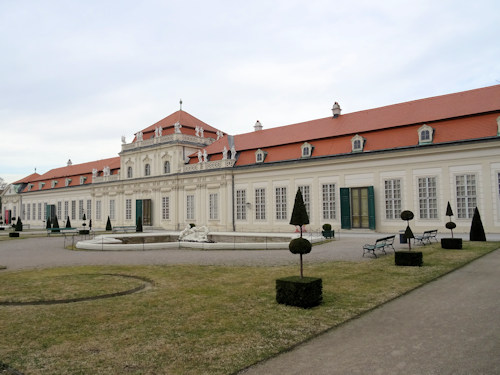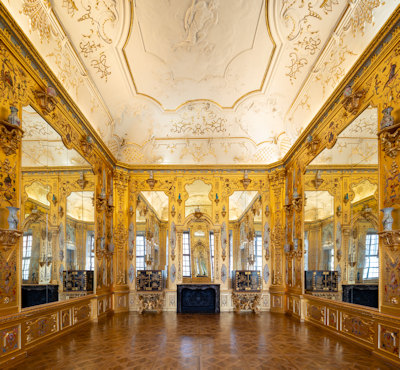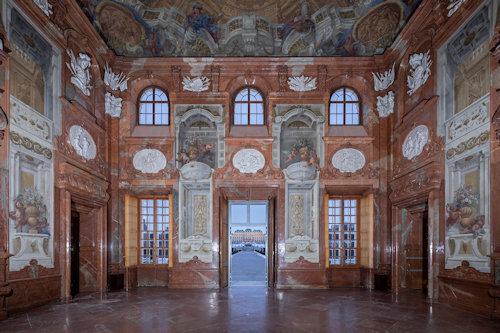
Upper Belvedere palace claims all the glory with its Klimts and Schieles, but its smaller sibling at the other end of the gardens also combines art with classic Baroque architecture. Welcome to Lower Belvedere.
- Top exhibitions in the palace & Orangerie
- Medieval collection in the former stables
- Baroque interiors and privy garden
- What special exhibitions are on?
- Book Lower Belvedere tickets*
- See also:
- Belvedere overview (and visitor tips)
- Selected past Belvedere exhibitions
Quick Lower Belvedere tickets
(Booking service provided by Tiqets.com*, who I am an affiliate of)
Art, marble & more
So what does this Baroque residence have to offer?
Well, the upper palace casts a long shadow thanks to its outstanding permanent displays of art. But Lower Belvedere often hosts some quite remarkable special exhibitions of its own. These use gallery space in the east wing of the palace and the orangery.
Recent exhibitions have covered the likes of Louise Bourgeois, Gustav Klimt, and Salvador Dalí. (See what I mean?)

(Rear view of Lower Belvedere palace)
Architecture & more
Don’t feel a visit is wasted, though, should the current exhibitions not match your interests. The palace has its own historical highlights to see inside too, as well as a permanent medieval art collection and a privy garden.
Several rooms still contain Baroque elements (like a decorated ceiling) or retain pretty much all their original and magnificent glory. For example…
Marmorsaal (Marble hall)
Located in the main exhibition tract, the Marmorsaal forms the centrepiece (literally and figuratively) of Lower Belvedere palace.
This large two-storey hall feels like Prince Eugene‘s personality expressed in marble and stone.
Let your eye wander across the numerous reliefs depicting hard-earned military trophies, statues of shackled enemies, and balconies and alcoves formed by paintings designed to create architectural illusions.
And, of course, the ceiling fresco has Eugene receiving honors from the Pope via the god, Mercury. It’s all rather impressive.
So let us forgive Eugene his vanity, because without it we wouldn’t have this Baroque splendor to marvel at. To think Lower Belvedere is supposed to be the more functional of the two palaces!
Most of the other rooms to the east of the main entrance and shop area are now exhibition galleries. But you may still discover a marble-edged ceiling within, painted to look like a giant stone dome.
The rooms to the west of the entrance, however, contain more stateroom highlights…
(The marble hall; press photo © Johannes Stoll / Belvedere, Wien)
Groteskensaal
The Groteskensaal (Hall of Grotesques) with its patterned marble floor adjoins the shop area and leads out to the west wing. Despite the name, no disfigured mummies or similar lurk within.
“Grotesque” refers to a fanciful style of decoration popular in Ancient Rome, with flowing, quasi-floral patterns that feature botanical, zoological and mythological elements, often with caricatures.
Moving on takes you through the marble gallery, golden room, and out to…
- The Orangery: once home to citrus fruits, now used for those special art exhibitions
- The Prunkstall stables: also converted to galleries and featuring Belvedere’s medieval collection
- The Kammergarten: a privy garden that stretches up alongside the main gardens

(Lower Belvedere’s Goldkabinett; press photo © Lukas Schaller / Belvedere, Wien)
Marble gallery (Marmorgallerie)
As the name cunningly suggests, the floors and walls here are marble, interlaced with stucco reliefs. Imagine a Wedgwood plate turned into a room.
Large mirrors at either end add a white marble vastness to the ambience.
This room also serves as another illustration of the two themes that permeate much of Belvedere: military victories and the vanity of Prince Eugene.
The ceiling includes a relief of said Prince receiving a laurel wreath from an angel, while a manifestation of peace drives away envy and hate (presumably modesty ran off much earlier).
As should be clear by now, it seems the house owner enjoyed depictions of himself basking in the glory of his military genius. Though to be fair, he earned it.
Golden room (Goldkabinett)
Originally a conversation room, the Golden Room was later decorated with golden walls, giant mirrors and grotesque paintwork, possibly making conversation impossible thanks to sensory overload.
Stand in front of the opposing mirrors and you see a never-ending cascade of gold and colored arches that exude imperial opulence and grandeur (the adaptations took place after Eugene’s heir sold the palace to Empress Maria Theresa).
It demands an awful lot of self-control not to take a selfie in front of those glorious mirrors.
Tickets & visitor tips
A ticket* for Lower Belvedere includes access to the exhibitions inside, as well as the Kammergarten, Orangery, and Prunkstall.
Special exhibitions
The current schedule at the time of writing is…
- Picturing Finland (until February 2nd, 2025): the first solo exhibition in Austria for the Finnish artist Akseli Gallen-Kallela
Next up:
- Proper Love (October 25th, 2024 to January 12th, 2025): the first solo museal exhibition in Europe for the Ghanaian artist Amoako Boafo, best known for his remarkable portrait work
Further tips:
- The main entrance gates lead directly off the road (Rennweg) to the large courtyard with the palace entrance opposite
- The palace has a serviced cloakroom and coin-operated lockers as well as its own café, and a shop with the traditional stock of books, souvenirs and similar
- For the best photos of the lower palace, go out into the gardens behind it and walk up the slope towards the upper palace
- The Vienna Pass (review) gets you into Lower Belvedere once for free
- Fans of TV & cinema might enjoy strolling the gardens leading away from Lower Belvedere and up to the upper palace. They featured in, for example, Season 3 of Vienna Blood and the feature film The Woman in Gold.
How to get to Lower Belvedere
See the directions article for Belvedere for detailed tips on how to reach the palace.
Address: Rennweg 6, 1030 Vienna
